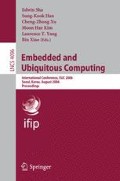Abstract
In this paper, we proposed a processor architecture that is suitable for next generation embedded applications, especially for personal information devices such as smart phones, PDAs, and handheld computers. Latest high performance embedded processors are developed to achieve high clock speed. Because increasing performance makes design more difficult and induces large overhead, architectural evolution in embedded processor field is necessary. Among more enhanced processor types, out-of-order superscalar cannot be a candidate for embedded applications due to its excessive complexity and relatively low performance gain compared to its overhead. Therefore, new architecture with moderate complexity must be designed. In this paper, we developed a low-cost SMT architecture model and compared its performance to other architectures including scalar, superscalar and multiprocessor. Because current personal information devices have a tendency to execute multiple tasks simultaneously, SMT or CMP can be a good choice. And our simulation result shows that the efficiency of SMT is the best among the architectures considered.
Access this chapter
Tax calculation will be finalised at checkout
Purchases are for personal use only
Preview
Unable to display preview. Download preview PDF.
References
Cormie, D.: The ARM11TM Microarchitecture, ARM Ltd. (2002)
Agarwal, V., Hrishikesh, M.S., Keckler, S.W., Burger, D.: Clock Rate versus IPC: The End of the Road for Conventional Microarchitectures. In: Proc. of the 27th Annual International Symposium on Computer Architectures, pp. 248–259 (2000)
Claasen: High speed: not the only way to exploit the intrinsic computational power of silicon, Digest of Technical Papers, Solid-state Circuits Conference, pp. 22–25 (1999)
Brinkschulte, U., Krakowski, C., Kreuzinger, J., Ungerer, T.: A Multithreaded Java Microcontroller for Thread-Oriented Real-Time Event Handling. In: Proceedings of the 1999 International Conference on Parallel Architectures and Compilation Techniques, October 12-16, p. 34 (1999)
Kreuzinger, J., Schulz, A., Pfeffer, M., Ungerer, T., Brinkschulte, U., Krakowski, C.: Real-time scheduling on multithreaded processors. In: The Proceedings of seventh international conference on Real-Time Systems and Applications, p. 155 (2000)
Tullsen, D.M., Eggers, S.J., Levy, H.M.: Simultaenous Multithreading: Maximizing On-Chip Parallelism. In: Proceedings of 22nd Annual International Symposium on Computer Architecture, Santa Margherita Ligure, Italy, May 1995, pp. 392–403 (1995)
Crowley, P., Fiuczynski, M.E., Baer, J., Bershad, B.N.: Characterizing Processor Architectures for Programmable Network Interfaces. In: Proceedings of the 2000 International Conference on Supercomputing (May 2000)
Glaskowsky, P.N.: Networking Gets XStream. Microprocessor Report (November 13, 2000)
Tullsen, D.M., Eggers, S.J., Emer, J.S., Levy, H.M.: Exploiting Choice: Instruction Fetch and Issue on an Implementable Simultaneous Multithreading Processor. In: Proceedings of 23rd Annual International Symposium on Computer Architecture, Philadelphia, Pennsylvania, May 1996, pp. 191–202 (1996)
Moon, B.I., Kim, M.G., Hong, I.P., Kim, K.C., Lee, Y.S.: Study of an In-order SMT Architecture and Grouping Schemes. International Journal of Control, Automation, and Systems 1(3), 339–350 (2003)
SimpleScalar Version 4.0 Test Releases, SimpleScalarLLC, http://www.simplescalar.com/v4test.html
Guthaus, M.R., Ringenberg, J.S., Ernst, D., Austin, T.M., Mudge, T., Brown, R.B.: MiBench: A free, commercially representative embedded benchmark suite. In: IEEE 4th Annual Workshop on Workload Characterization, Austin, Texas (December 2001)
ANSI/IEEE Std 802.11-1999 Wireless LAN Medium Access Control (MAC) and Physical Layer (PHY) Specifications
Mamidipaka, M., Dutt, N.: eCACTI: An Enhanced Power Estimation Model for On-chip Caches, Center for Embedded Computer Systems (CECS) Technical Report TR-04-28 (September 2004)
Author information
Authors and Affiliations
Editor information
Editors and Affiliations
Rights and permissions
Copyright information
© 2006 Springer-Verlag Berlin Heidelberg
About this paper
Cite this paper
Hong, IP., Lee, YJ., Lee, YS. (2006). Next Generation Embedded Processor Architecture for Personal Information Devices. In: Sha, E., Han, SK., Xu, CZ., Kim, MH., Yang, L.T., Xiao, B. (eds) Embedded and Ubiquitous Computing. EUC 2006. Lecture Notes in Computer Science, vol 4096. Springer, Berlin, Heidelberg. https://doi.org/10.1007/11802167_47
Download citation
DOI: https://doi.org/10.1007/11802167_47
Publisher Name: Springer, Berlin, Heidelberg
Print ISBN: 978-3-540-36679-9
Online ISBN: 978-3-540-36681-2
eBook Packages: Computer ScienceComputer Science (R0)

